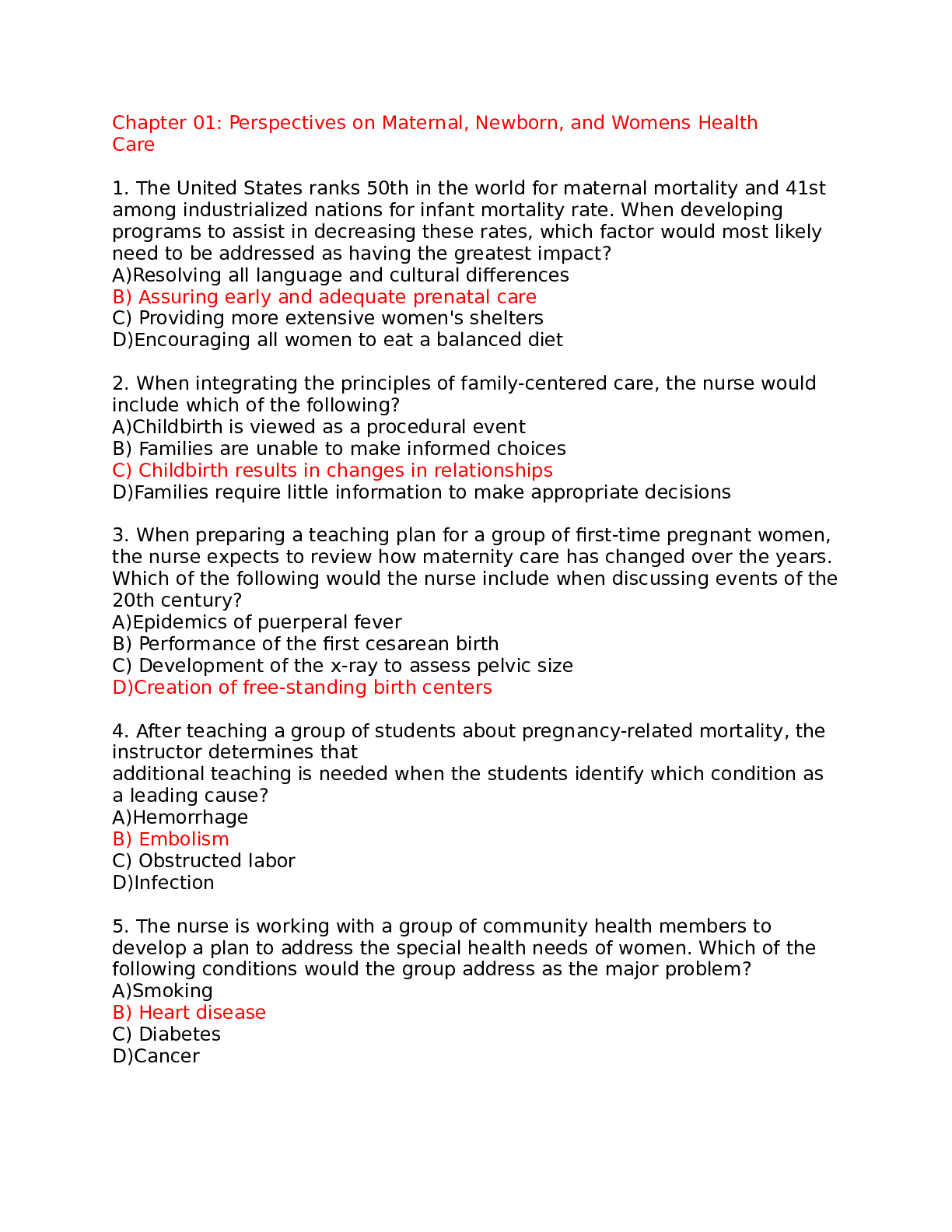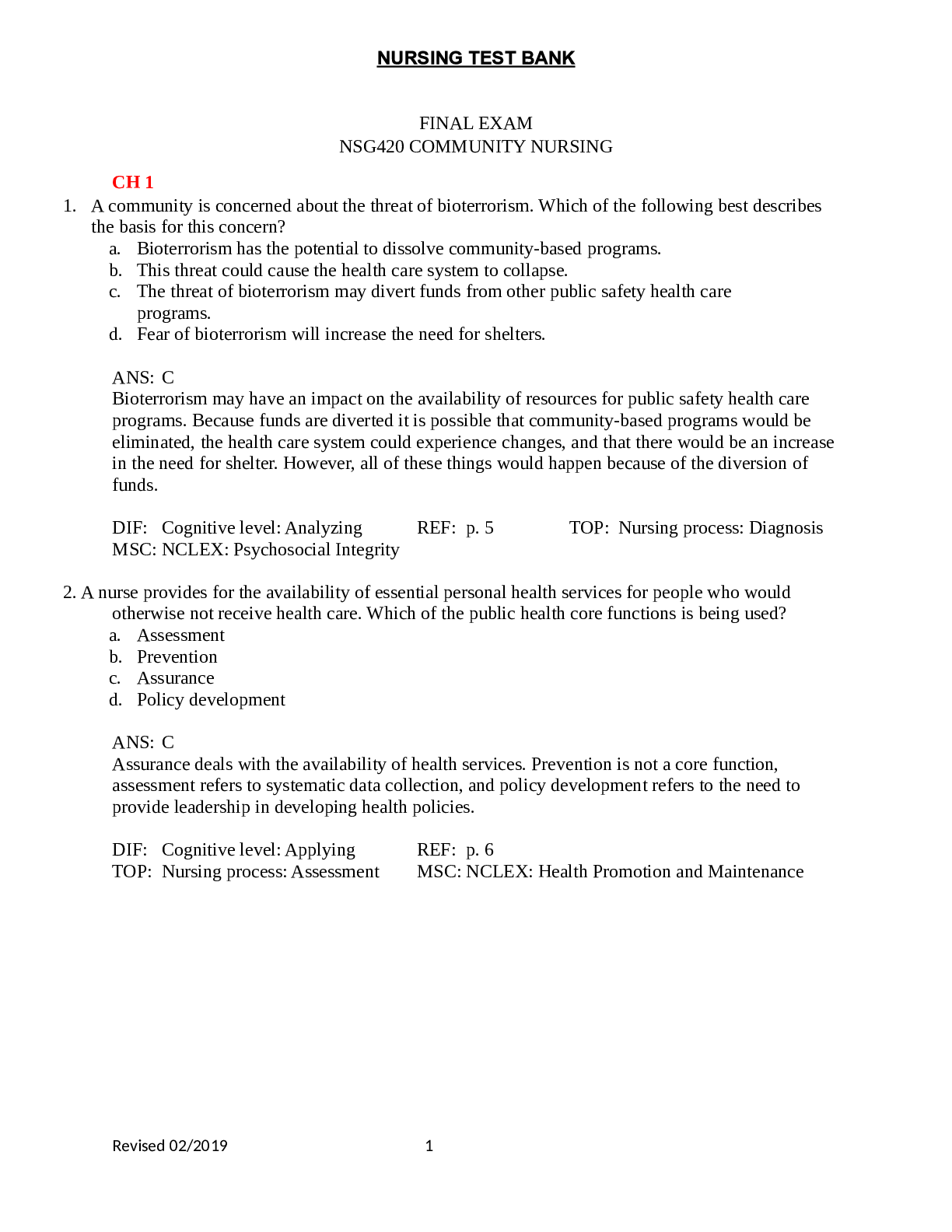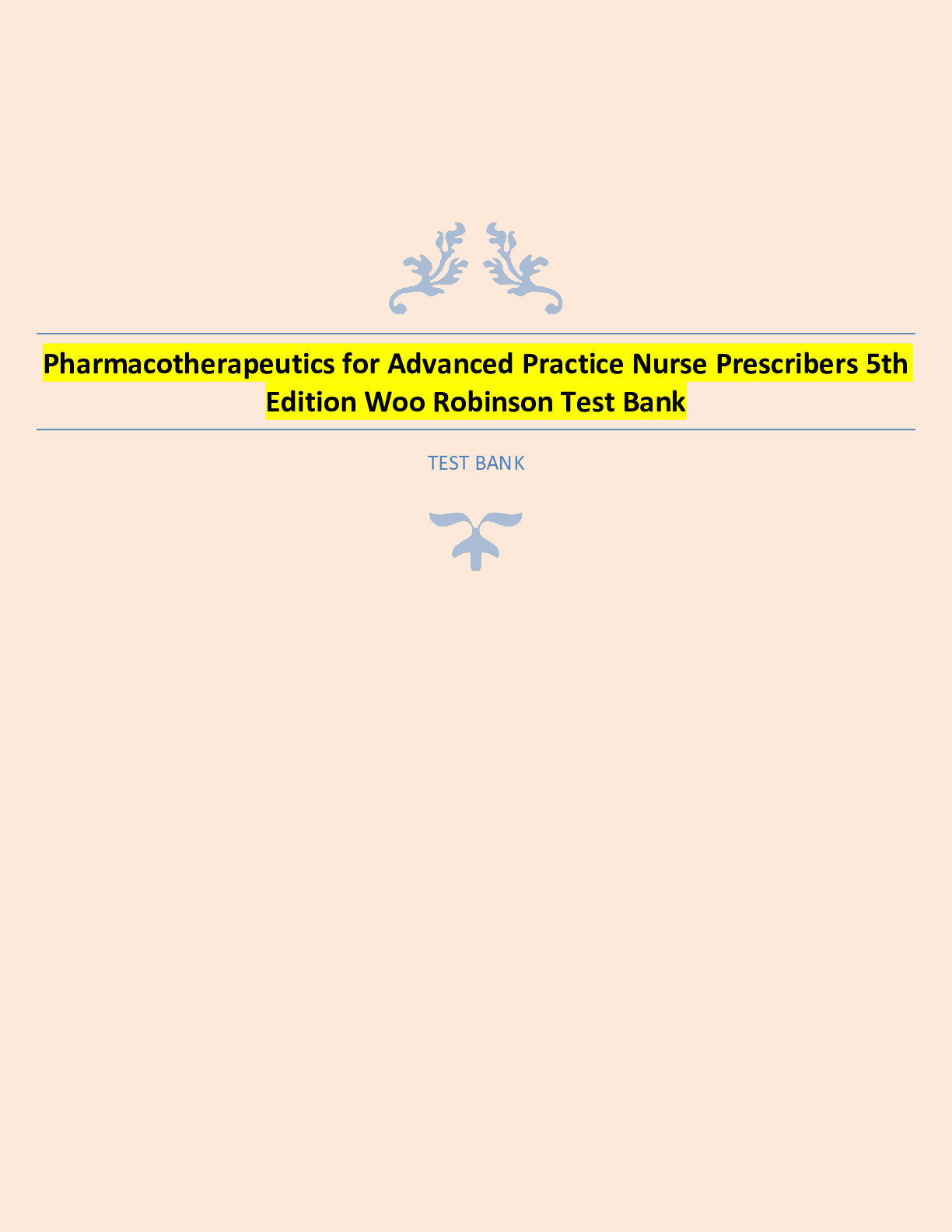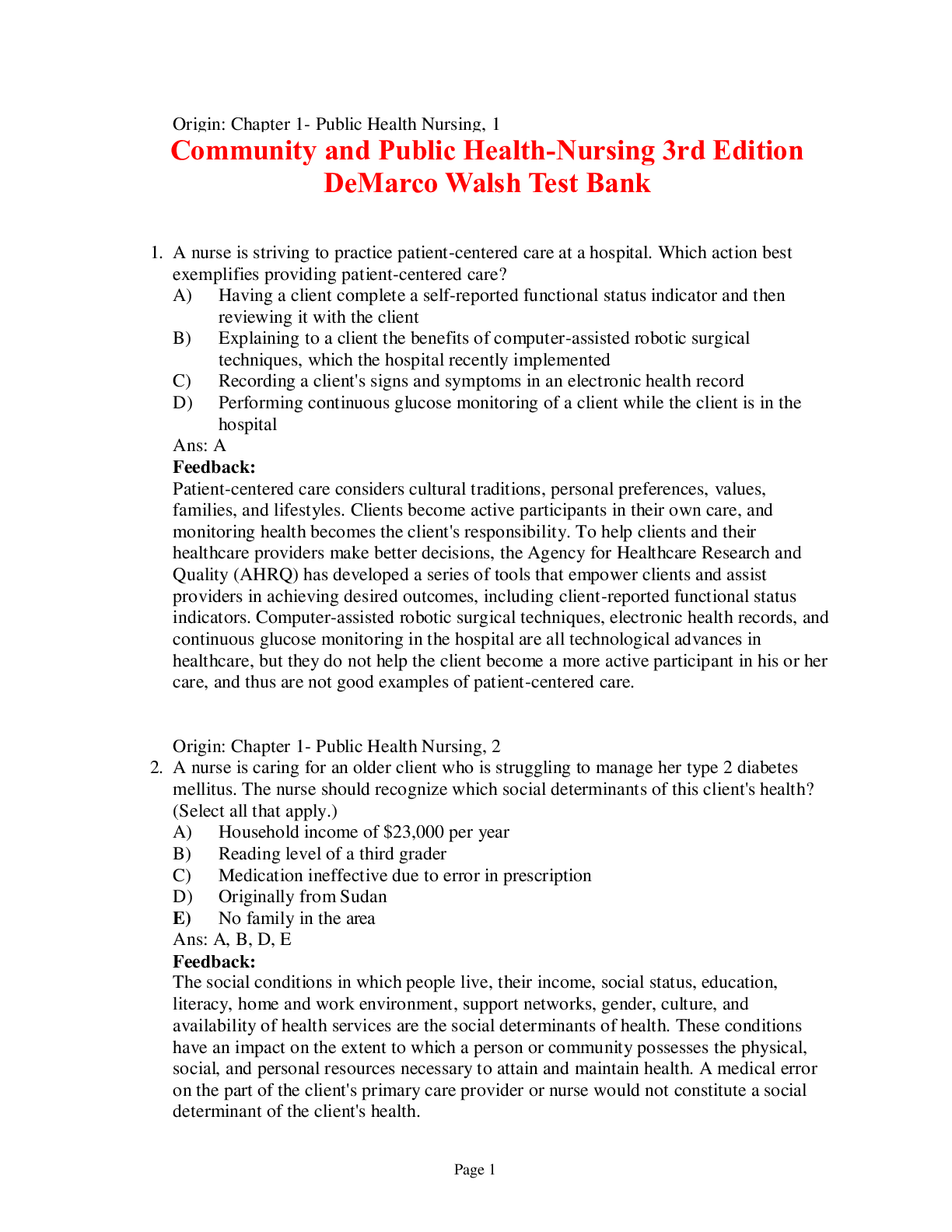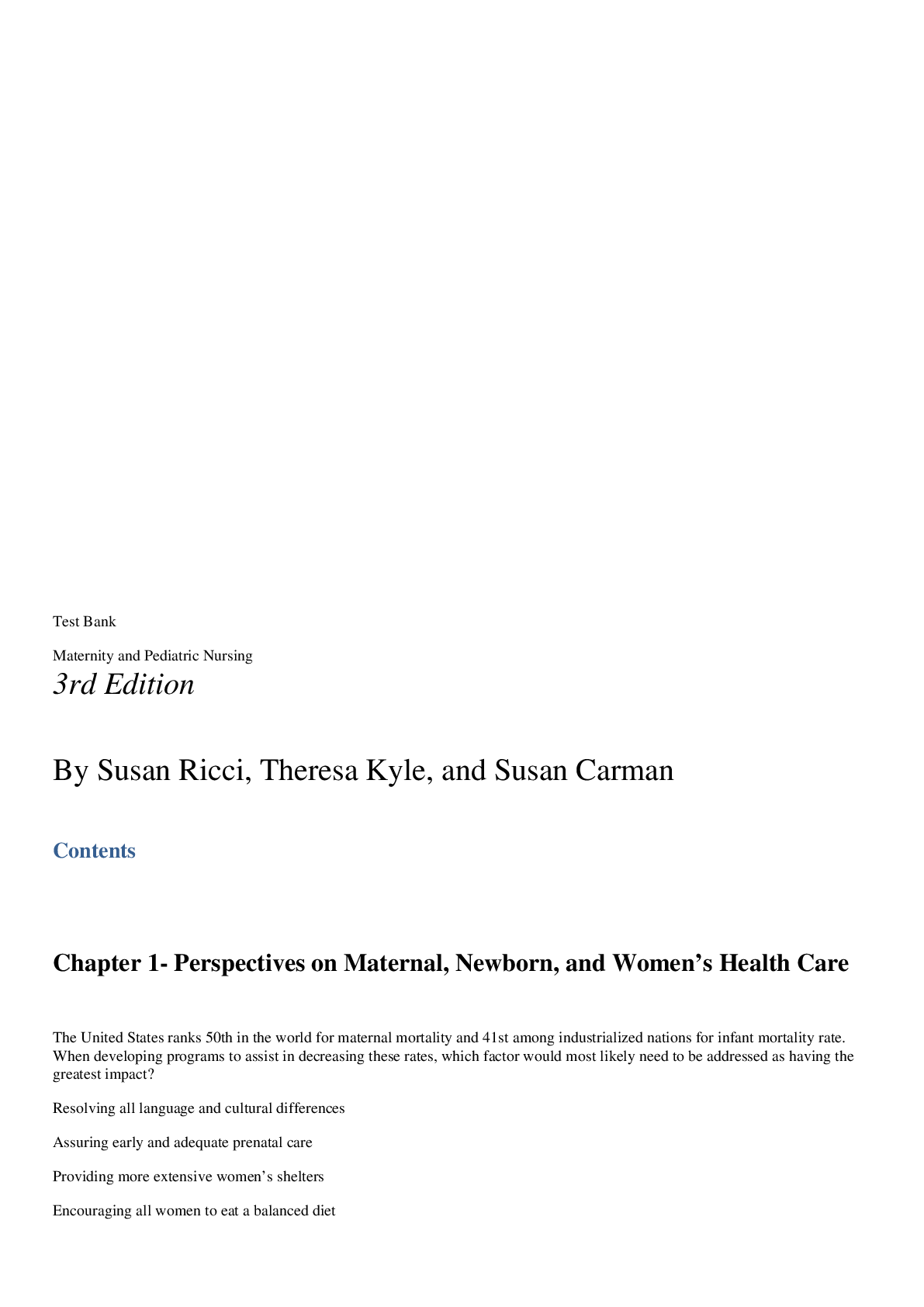*NURSING > TEST BANK > MATERNITY AND PEDIATRIC NURSING 3RD EDITION RICCI TEST BANK (all chapters questions & answers) Ace o (All)
MATERNITY AND PEDIATRIC NURSING 3RD EDITION RICCI TEST BANK (all chapters questions & answers) Ace on your studies > Latest 2021
Document Content and Description Below
NURSINGTB.COM TestBankW MaWeUniW and PediaWUic NXUVing - ThiUd EdiWion Chapter 4- Common Reproductive Issues 1. After discussing various methods of contraception with a client and her partner, the nur... se determines that the teaching was successful when they identify which contraceptive method as providing protection against sexually transmitted infections (STIs)? A) Oral contraceptives B) Tubal ligation C) Condoms D) Intrauterine system 2. When discussing contraceptive options, which method would the nurse recommend as being the most reliable? A) Coitus interruptus B) Lactational amenorrheal method (LAM) C) Natural family planning D) Intrauterine system 3. A client comes to the clinic with abdominal pain. Based on her history the nurse suspects endometriosis. The nurse expects to prepare the client for which of the following to confirm this suspicion? A) Pelvic examination B) Transvaginal ultrasound C) Laparoscopy D) Hysterosalpingogram 4. A client is to receive an implantable contraceptive. The nurse describes this contraceptive as containing: A) Synthetic progestin B) Combined estrogen and progestin C) Concentrated spermicide D) Concentrated estrogen 5. The nurse discusses various contraceptive methods with a client and her partner. Which method would the nurse explain as being available only with a prescription? A) Condom NURSINGTB.COM MATERNITY AND PEDIATRIC NURSING 3RD EDITION RICCI TEST BANKNURSINGTB.COM TestBankW B) Spermicide C) Diaphragm D) Basal body temperature 6. When developing a teaching plan for a couple considering contraception options, which of the following statements would the nurse include? A) ³YoX VhoXld VelecW one WhaW iV conVideUed Wo be 100% effecWiYe.´ B) ³The beVW one iV Whe one WhaW iV Whe leaVW e[SenViYe and moVW conYenienW.´ C) ³A good conWUaceSWiYe doeVn¶W UeTXiUe a ShVician¶V SUeVcUiSWion.´ D) ³The beVW conWUaceSWiYe iV one WhaW oX Zill XVe coUUecWl and conViVWenWl.´ 7. Which of the following measures would the nurse include in the teaching plan for a woman to reduce the risk of osteoporosis after menopause? A) Taking vitamin supplements B) Eating high-fiber, high-calorie foods C) Restricting fluid to 1,000 mL daily D) Participating in regular daily exercise 8. When teaching a group of postmenopausal women about hot flashes and night sweats, the nurse would address which of the following as the primary cause? A) Poor dietary intake B) Estrogen deficiency C) Active lifestyle D) Changes in vaginal pH 9. A client states that she is to have a test to measure bone mass to help diagnose osteoporosis. The nurse would most likely plan to prepare the client for: A) DEXA scan B) Ultrasound C) MRI D) Pelvic x-ray 10. The nurse is reviewing the medical records of several clients. Which client would the nurse expect to have an increased risk for developing osteoporosis? A) A woman of African American descent B) A woman who plays tennis twice a week C) A thin woman with small bones D) A woman who drinks one cup of coffee a day NURSINGTB.COM MATERNITY AND PEDIATRIC NURSING 3RD EDITION RICCI TEST BANKNURSINGTB.COM TestBankW 11. Which of the following would the nurse emphasize when teaching postmenopausal women about ways to reduce the risk of osteoporosis? A) Swimming daily B) Taking vitamin A C) Following a low-fat diet D) Taking calcium supplements 12. Which finding would the nurse expect to find in a client with endometriosis? A) Hot flashes B) Dysuria C) Fluid retention D) Fever 13. After the nurse teaches a client about ways to reduce the symptoms of premenstrual syndrome, which client statement indicates a need for additional teaching? A) ³I Zill make VXUe Wo Wake m eVWUogen VXSSlemenWV a Zeek befoUe m SeUiod.´ B) ³I¶Ye Vigned XS foU an aeUobic e[eUciVe claVV WhUee WimeV a Zeek.´ C) ³I¶ll cXW doZn on Whe amoXnW of coffee and colaV I dUink.´ D) ³I TXiW Vmoking aboXW a monWh ago, Vo WhaW VhoXld helS.´ 14. A woman has opted to use the basal body temperature method for contraception. The nurse instructs the client that a rise in basal body temperature indicates which of the following? A) Onset of menses B) Ovulation C) Pregnancy D) Safe period for intercourse 15. A woman using the cervical mucus ovulation method of fertility awareness reports that her cervical mucus looks like egg whites. The nurse interprets this as which of the following? A) Spinnbarkeit mucus B) Purulent mucus C) Postovulatory mucus D) Normal preovulation mucus 16. The nurse is reviewing the laboratory test results of a client with dysfunctional uterine bleeding (DUB). Which finding would be of concern? A) Negative pregnancy test NURSINGTB.COM MATERNITY AND PEDIATRIC NURSING 3RD EDITION RICCI TEST BANKNURSINGTB.COM TestBankW B) Hemoglobin level of 10.1 g/dL C) Prothrombin time of 60 seconds D) Serum cholesterol of 140 mg/dL 17. A nurse is preparing a class for a group of women at a family planning clinic about contraceptives. When describing the health benefits of oral contraceptives, which of the following would the nurse most likely include? (Select all that apply.) A) Protection against pelvic inflammatory disease B) Reduced risk for endometrial cancer C) Decreased risk for depression D) Reduced risk for migraine headaches E) Improvement in acne 18. After teaching a group of students about the different methods for contraception, the instructor determines that the teaching was successful when the students identify which of the following as a mechanical barrier method? (Select all that apply.) A) Condom B) Cervical cap C) Cervical sponge D) Diaphragm E) Vaginal ring 19. After assessing a woman who has come to the clinic, the nurse suspects that the woman is experiencing dysfunctional uterine bleeding. Which statement by the clienW ZoXld VXSSoUW Whe nXUVe¶V VXVSicionV? A) ³I¶Ye been haYing bleeding off and on WhaW¶V iUUegXlaU and VomeWimeV heaY.´ B) ³I geW VhaUS Sain in m loZeU abdomen XVXall VWaUWing soon after my period comeV.´ C) ³I geW Ueall iUUiWable and mood aboXW a Zeek befoUe m SeUiod.´ D) ³M SeUiodV haYe been XnXVXall long and heaY laWel.´ 20. After teaching a group of students about premenstrual syndrome, the instructor determines that additional teaching is needed when the students identify which of the following as a prominent assessment finding? A) Bloating B) Tension C) Dysphoria D) Weight loss 21. NURSINGTB.COM MATERNITY AND PEDIATRIC NURSING 3RD EDITION RICCI TEST BANKNURSINGTB.COM TestBankW A nurse is describing the criteria needed for the diagnosis of premenstrual dysphoric disorder (PMDD). Which of the following would the nurse include as a mandatory requirement for the diagnosis? A) Appetite changes B) Sleep difficulties C) Persistent anger D) Chronic fatigue 22. When reviewing the medical record of a client diagnosed with endometriosis, which of the following would the nurse identify as a risk factor for this woman? A) Low fat in the diet B) Age of 14 years for menarche C) Menstrual cycles of 24 days D) Short menstrual flow 23. A client who has come to the clinic is diagnosed with endometriosis. Which of the following would the nurse expect the physician to prescribe as a first-line treatment? A) Progestins B) Antiestrogens C) Gonadotropin-releasing hormone analogues D) NSAIDs 24. A woman comes to the clinic because she has been unable to conceive. When UeYieZing Whe Zoman¶V hiVWoU, Zhich of the following would the nurse least likely identify as a possible risk factor? A) Age of 25 years B) History of smoking C) Diabetes since age 15 years D) Weight below standard for height and age 25. A couple comes to the clinic for a fertility evaluation. The male partner is to undergo a semen analysis. After teaching the partner about this test, which client statement indicates that the client has understood the instructions? A) ³I need Wo bUing Whe VSecimen Wo Whe lab Whe da afWeU collecWing iW.´ B) ³I Zill Slace Whe VSecimen in a VSecial SlaVWic bag Wo WUanVSoUW iW.´ C) ³I haYe Wo abVWain fUom Ve[Xal acWiYiW foU aboXW 1±2 daV befoUe Whe VamSle.´ D) ³I Zill ZiWhdUaZ befoUe I ejacXlaWe dXUing Ve[ Wo collecW Whe VSecimen.´ 26. NURSINGTB.COM MATERNITY AND PEDIATRIC NURSING 3RD EDITION RICCI TEST BANKNURSINGTB.COM TestBankW A nurse is preparing a class for a group of young adult women about emergency contraceptives (ECs). Which of the following would the nurse need to stress to the group. Select all that apply. A) ECs induce an abortion like reaction. B) ECs provide some protection against STIs C) ECs are birth control pills in higher, more frequent doses D) ECs are not to be used in place of regular birth control E) ECs provide little protection for future pregnancies. NURSINGTB.COM MATERNITY AND PEDIATRIC NURSING 3RD EDITION RICCI TEST BANKNURSINGTB.COM TestBankW MaWeUniW and PediaWUic NXUVing - ThiUd EdiWion Chapter 5- Sexually Transmitted Infections 1. The nurse is developing a plan of care for a client who is receiving highly active antiretroviral therapy (HAART) for treatment of HIV. The goal of this therapy is to: A) Promote the progression of disease B) Intervene in late-stage AIDS C) Improve survival rates D) Conduct additional drug research 2. A woman who is HIV-positive is receiving HAART and is having difficulty with compliance. To promote adherence, which of the following areas would be most important to assess initially? A) The Zoman¶s beliefs and edXcaWion B) The Zoman¶s financial siWXaWion and insXrance C) The Zoman¶s acWiYiW leYel and nXWriWion D) The Zoman¶s famil and liYing arrangemenWs 3. When developing a teaching plan for a community group about HIV infection, which group would the nurse identify as an emerging risk group for HIV infection? A) Native Americans B) Heterosexual women C) New health care workers D) Asian immigrants 4. After teaching a group of adolescents about HIV, the nurse asks them to identify the major means by which adolescents are exposed to the virus. The nurse determines that the teaching was successful when the group identifies which of the following? A) Sexual intercourse B) Sharing needles for IV drug use C) Perinatal transmission D) Blood transfusion 5. NURSINGTB.COM MATERNITY AND PEDIATRIC NURSING 3RD EDITION RICCI TEST BANKNURSINGTB.COM TestBankW The nurse reviews the CD4 cell count of a client who is HIV-positive. A result less than which of the following would indicate to the nurse that the client has AIDS? A) 1,000 cells/mm3 B) 700 cells/mm3 C) 450 cells/mm3 D) 200 cells/mm3 6. When obtaining the health history from a client, which factor would lead the nurse to suspect that the client has an increased risk for sexually transmitted infections (STIs)? A) Hive-like rash for the past 2 days B) Five different sexual partners C) Weight gain of 5 lbs in 1 year D) Clear vaginal discharge 7. Assessment of a female client reveals a thick, white vaginal discharge. She also reports intense itching and dyspareunia. Based on these findings, the nurse would suspect that the client has: A) Trichomoniasis B) Bacterial vaginosis C) Candidiasis D) Genital herpes simplex 8. A client with trichomoniasis is to receive metronidazole (Flagyl). The nurse instructs the client to avoid which of the following while taking this drug? A) Alcohol B) Nicotine C) Chocolate D) Caffeine 9. A Zoman giYes birWh Wo a healWh neZborn. As parW of Whe neZborn¶s care, Whe nurse instills erythromycin ophthalmic ointment as a preventive measure related to which STI? A) Genital herpes B) Hepatitis B C) Syphilis D) Gonorrhea 10. Which findings would the nurse expect to find in a client with bacterial vaginosis? A) Vaginal pH of 3 NURSINGTB.COM MATERNITY AND PEDIATRIC NURSING 3RD EDITION RICCI TEST BANKNURSINGTB.COM TestBankW B) Fish-like odor of discharge C) Yellowish-green discharge D) Cervical bleeding on contact 11. A pregnant woman diagnosed with syphilis comes to the clinic for a visit. The nurse discusses the risk of transmitting the infection to her newborn, explaining that this infection is transmitted to the newborn through the: A) Amniotic fluid B) Placenta C) Birth canal D) Breast milk 12. The nurse encourages a female client with human papillomavirus (HPV) to receive continued follow-up care because she is at risk for: A) Infertility B) Dyspareunia C) Cervical cancer D) Dysmenorrhea 13. A client is diagnosed with pelvic inflammatory disease (PID). When reviewing the clienW¶s medical record, Zhich of Whe following would the nurse expect to find? (Select all that apply.) A) Oral temperature of 100.4 degrees F B) Dysmenorrhea C) Dysuria D) Lower abdominal tenderness E) Discomfort with cervical motion F) Multiparity 14. Which instructions would the nurse include when teaching a woman with pediculosis pubis? A) ³Take Whe anWibioWic XnWil oX feel beWWer.´ B) ³Wash oXr bed linens in bleach and cold ZaWer.´ C) ³YoXr parWner doesn¶W need WreaWmenW aW Whis Wime.´ D) ³RemoYe Whe niWs ZiWh a fine-WooWhed comb.´ 15. A clienW ZiWh geniWal herpes simple[ infecWion asks Whe nXrse, ³Will I eYer be cXred of Whis infecWion?´ Which response by the nurse would be most appropriate? A) ³There is a neZ Yaccine aYailable WhaW preYenWs Whe infecWion from reWXrning.´ B) ³All oX need is a dose of penicillin and Whe infecWion Zill be gone.´ C) ³There is no cXre, bXW drXg Wherap helps Wo redXce smpWoms and recXrrences.´ NURSINGTB.COM MATERNITY AND PEDIATRIC NURSING 3RD EDITION RICCI TEST BANKNURSINGTB.COM TestBankW D) ³Once oX haYe Whe infecWion, oX deYelop an immXniW Wo iW.´ 16. A nurse is preparing a presentation for a group of women at the clinic who have been diagnosed with genital herpes. Which of the following would the nurse expect to include as a possible precipitating factor for a recurrent outbreak? (Select all that apply.) A) Exposure to ultraviolet light B) Exercise C) Use of corticosteroids D) Emotional stress E) Sexual intercourse. 17. After teaching a class on sexually transmitted infections, the instructor determines that the teaching was successful when the class identifies which statement as true? A) STIs can affect anyone if exposed to the infectious organism. B) STIs have been addressed more on a global scale. C) Clients readily view the diagnosis of STI openly. D) Most individuals with STIs are over the age of 30. 18. A group of students are reviewing information about STIs. The students demonstrate understanding of the information when they identify which of the following as the most common bacterial STI in the United States? A) Gonorrhea B) Chlamydia C) Syphilis D) Candidiasis 19. A nurse is assessing a client for possible risk factors for chlamydia and gonorrhea. Which of the following would the nurse identify? A) Asian American ethnicity B) Age under 25 years C) Married D) Consistent use of barrier contraception 20. A nurse at a local community clinic is developing a program to address STI prevention. Which of the following would the nurse least likely include in the program? A) Outlining safer sexual behavior B) Recommending screening for symptomatic individuals NURSINGTB.COM MATERNITY AND PEDIATRIC NURSING 3RD EDITION RICCI TEST BANKNURSINGTB.COM TestBankW C) Promoting the use of barrier contraceptives D) Offering education about STI transmission 21. After teaching a class on preventing pelvic inflammatory disease, the instructor determines that the teaching was successful when the class identifies which of the following as an effective method? A) Advising sexually active females to use hormonal contraception B) Encouraging vaginal douching on a weekly basis. C) Emphasizing the need for infected sexual partners to receive treatment D) Promoting routine treatment for asymptomatic females as risk 22. A group of nursing students are reviewing information about vaccines used to prevent STIs. The students would expect to find information about which of the following? A) HIV B) HSV C) HPV D) HAV E) HBV 23. A mother brings her 12-year-old daughter in for well-visit checkup. During the visit, the nurse is discussing the use of prophylactic HPV vaccine for the daughter. The mother agrees and the daughter receives her first dose. The nurse schedules the daughter for the next dose, which would be given at which time? A) In 2 month B) In 2 months C) In 3 months D) In 4 months 24. A woman comes to the clinic complaining of a vaginal discharge. The nurse suspects trichomoniasis based on which of the following? (Select all that apply.) A) Urinary frequency B) Yellow/green discharge C) Joint pain D) Blister-like lesions E) Muscle aches 25. A nurse is teaching a women with genital ulcers how to care for them. Which statement by the client indicates a need for additional teaching? A) ³I need Wo Zash m hands afWer WoXching an of Whe Xlcers.´ NURSINGTB.COM MATERNITY AND PEDIATRIC NURSING 3RD EDITION RICCI TEST BANKNURSINGTB.COM TestBankW B) ³I need Wo absWain from inWercoXrse primaril Zhen Whe lesions are presenW.´ C) ³I shoXld aYoid appling ice or heaW Wo m geniWal area.´ D) ³I can Wr lXkeZarm siW] baWhs Wo help ease Whe discomforW.´ NURSINGTB.COM MATERNITY AND PEDIATRIC NURSING 3RD EDITION RICCI TEST BANKNURSINGTB.COM TestBankW Maternity and Pediatric Nursing - Third Edition Chapter 9- Violence and Abuse 1. The nurse is presenting a class at a local community health center on violence during pregnancy. Which of the following would the nurse include as a possible complication? A) Hypertension of pregnancy B) Chorioamnionitis C) Placenta previa D) Postterm labor 2. Which approach would be most appropriate when counseling a woman who is a suspected victim of violence? A) Offer her a pamphlet about the local battered women’s shelter. B) Call her at home to ask her some questions about her marriage. C) Wait until she comes in a few more times to make a better assessment. D) Ask, “Have you ever been physically hurt by your partner?” 3. When describing an episode, the victim reports that she attempted to calm her partner down to keep things from escalating. This behavior reflects which phase of the cycle of violence? A) Battering B) Honeymoon C) Tension-building D) Reconciliation 4. A battered pregnant woman reports to the nurse that her husband has stopped hitting her and promises never to hurt her again. Which of the following is an appropriate response? A) “That’s great. I wish you both the best.” B) “The cycle of violence often repeats itself.” C) “He probably didn’t mean to hurt you.” D) “You need to consider leaving him.” 5. Which of the following nursing actions would be least helpful for a client who is a victim of violence? A) Assist the client to project her anger. B) Provide information about a safe home and crisis line. [Show More]
Last updated: 1 year ago
Preview 1 out of 39 pages
Instant download
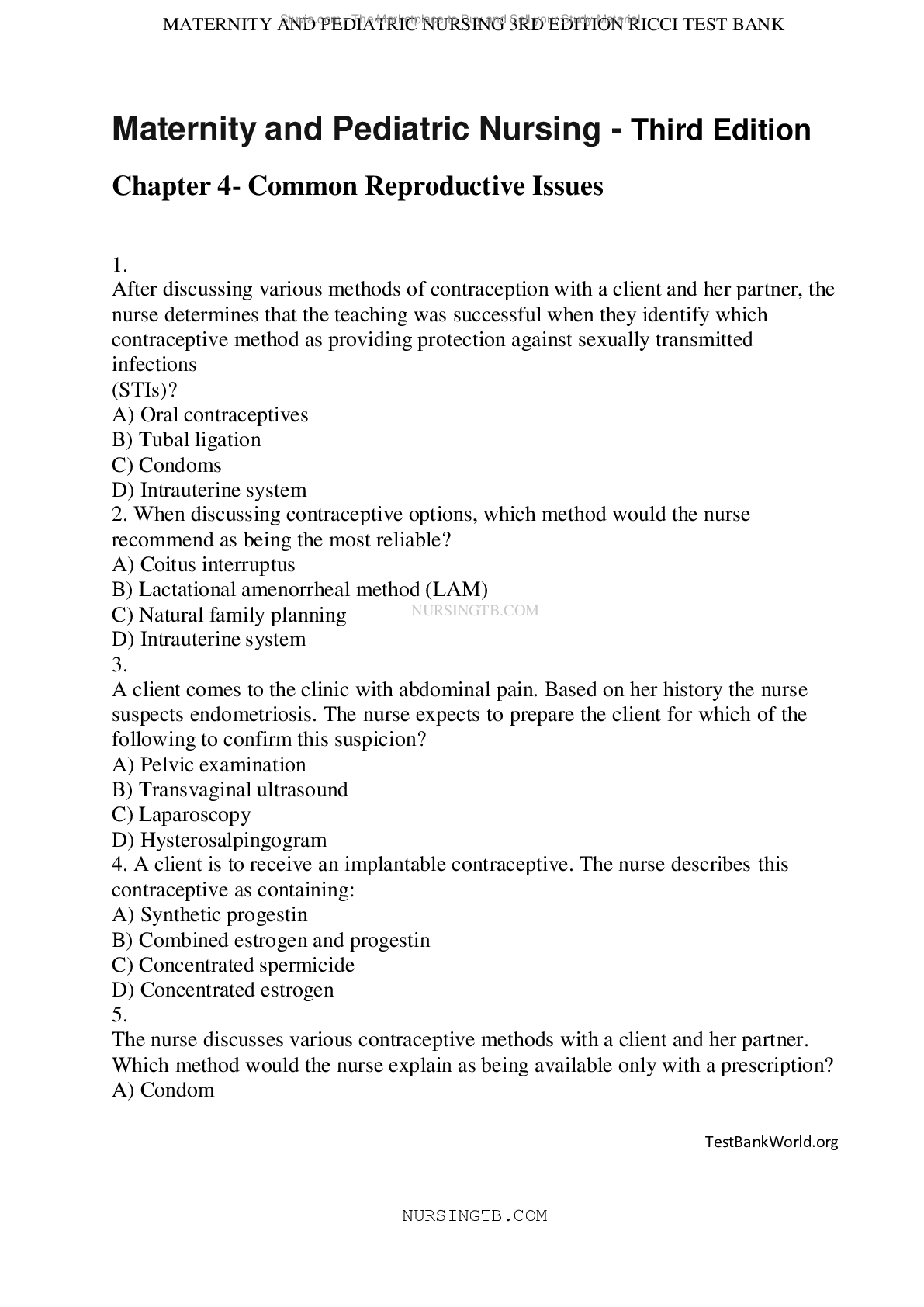
Buy this document to get the full access instantly
Instant Download Access after purchase
Add to cartInstant download
Reviews( 0 )
Document information
Connected school, study & course
About the document
Uploaded On
May 21, 2021
Number of pages
39
Written in
Additional information
This document has been written for:
Uploaded
May 21, 2021
Downloads
0
Views
45





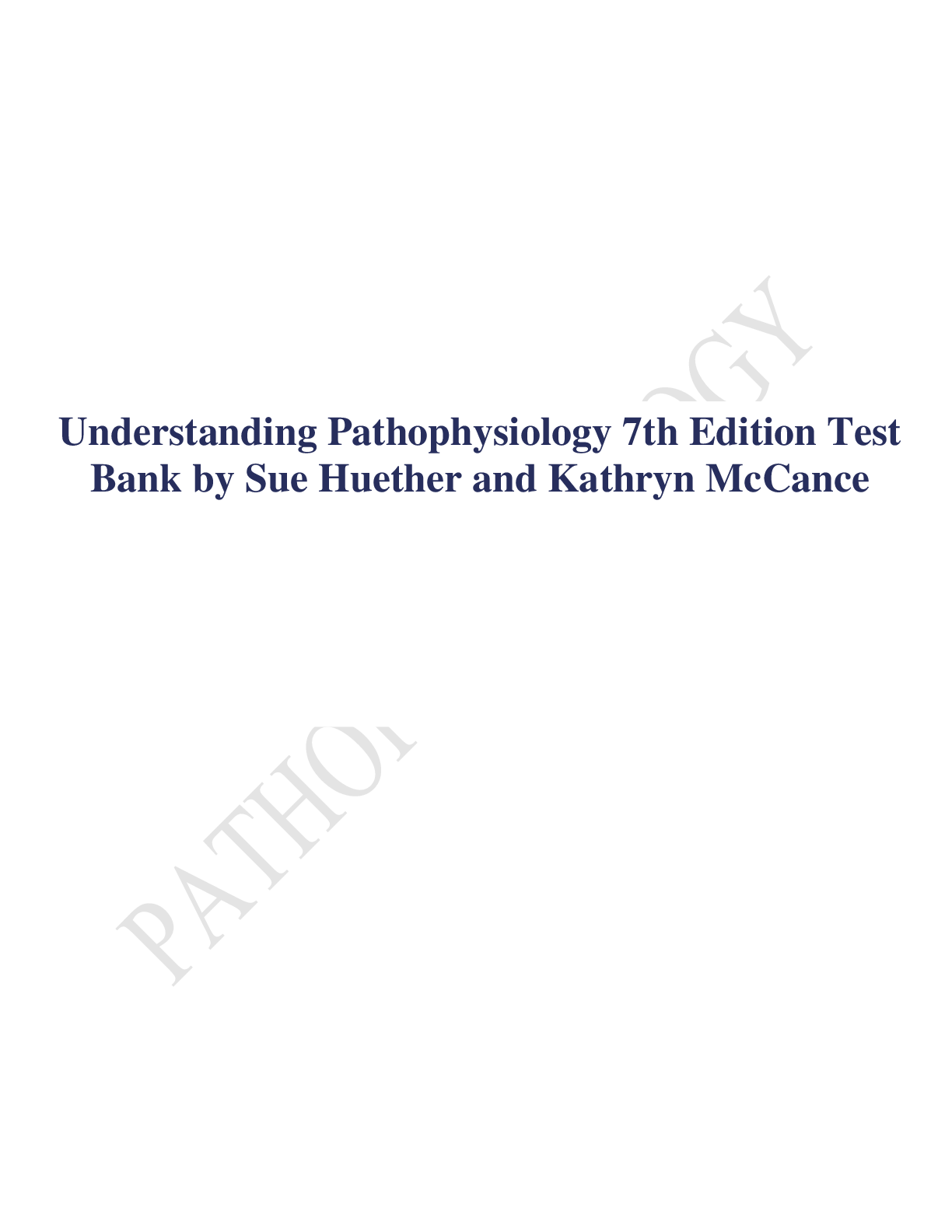


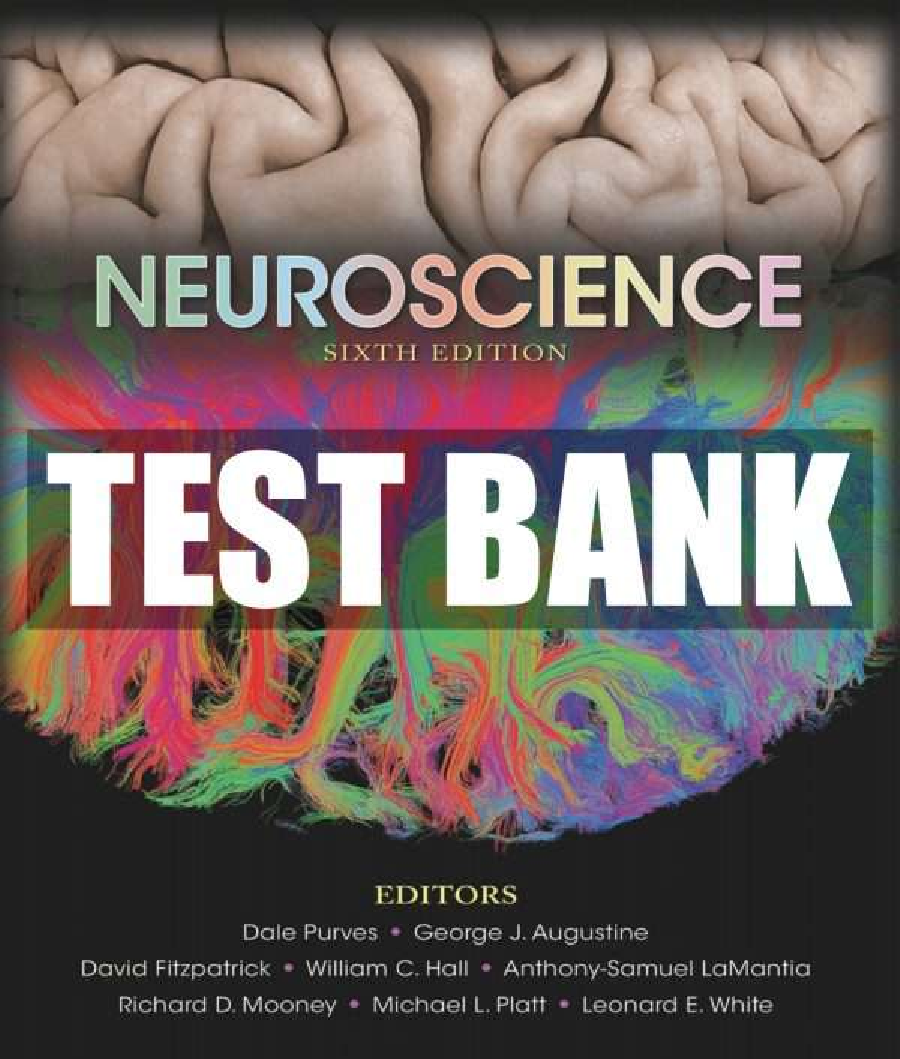




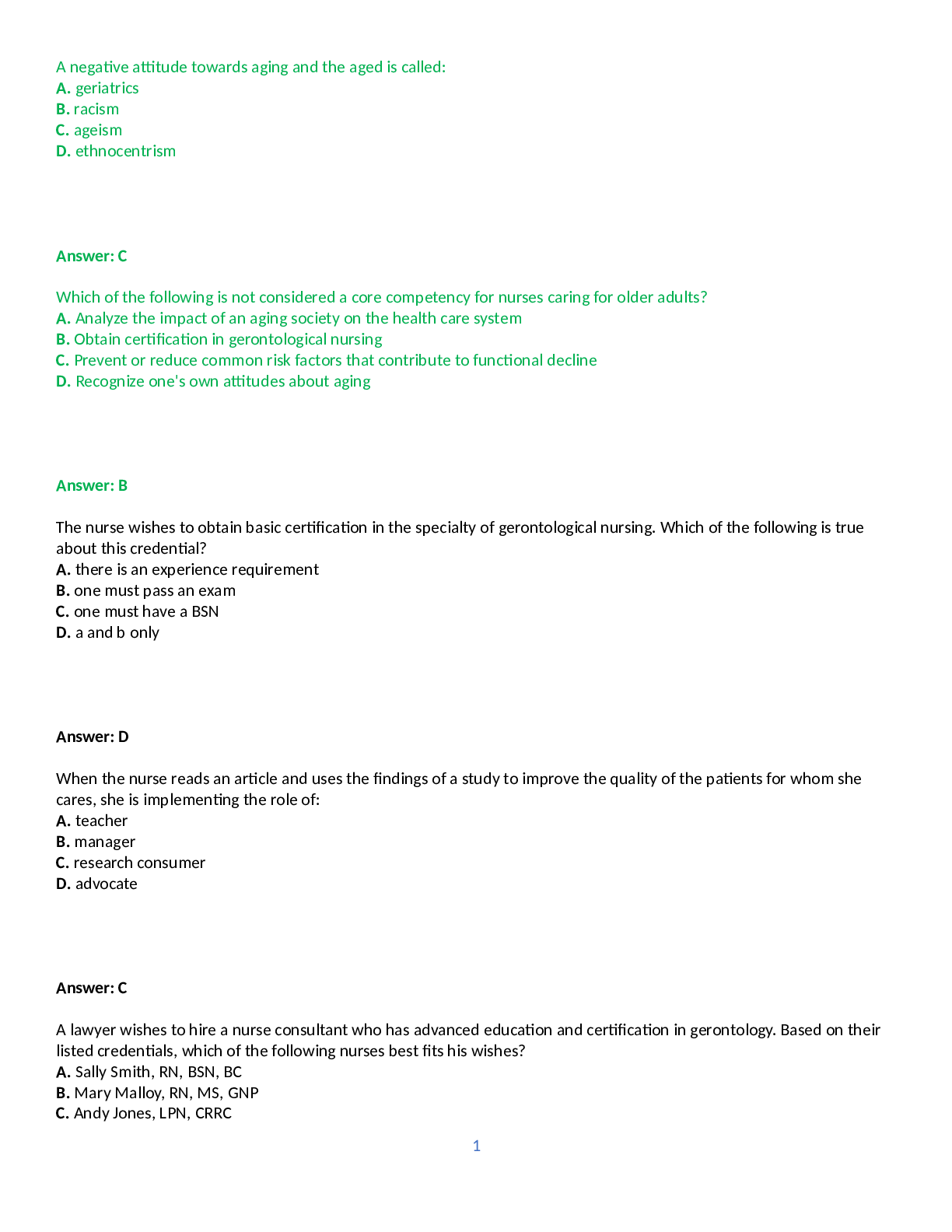
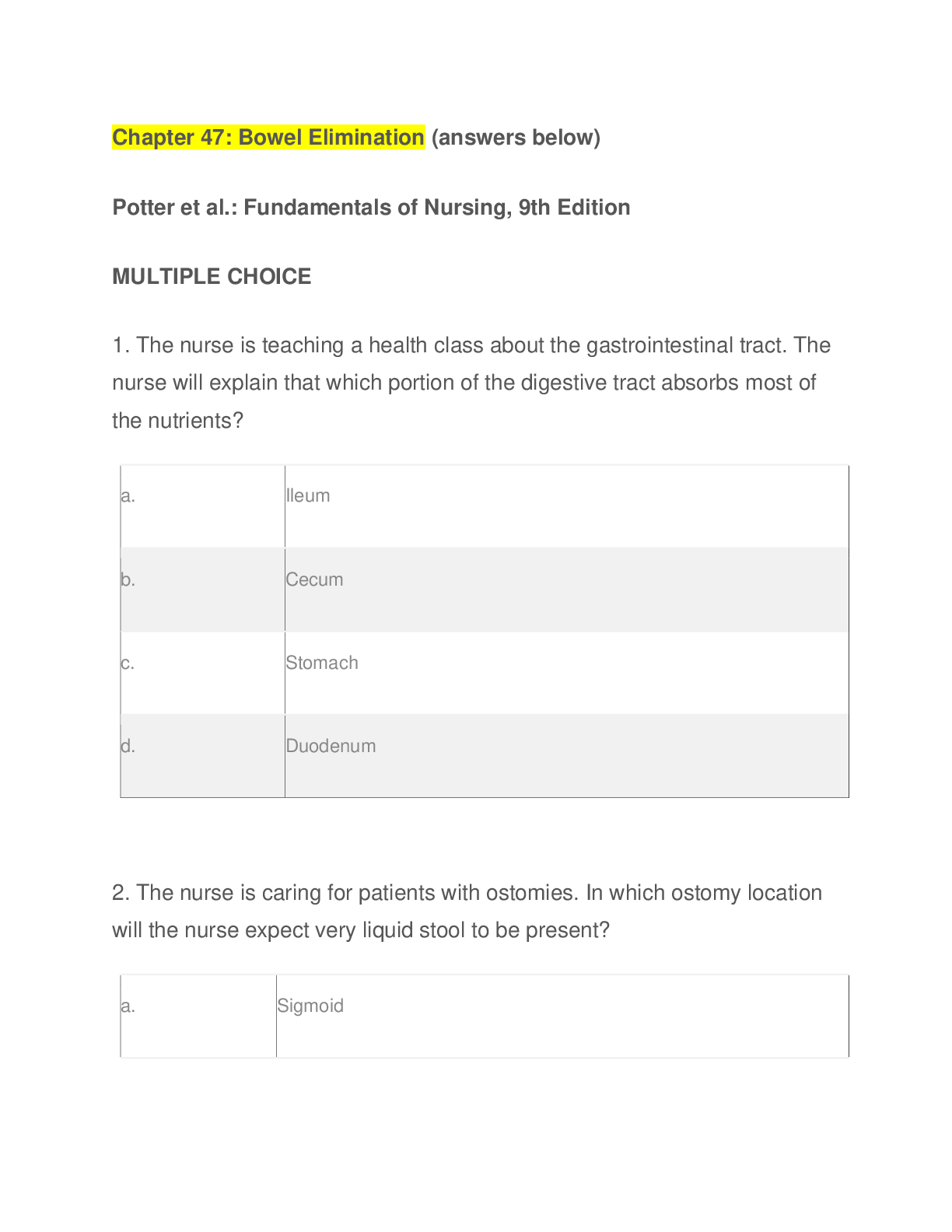

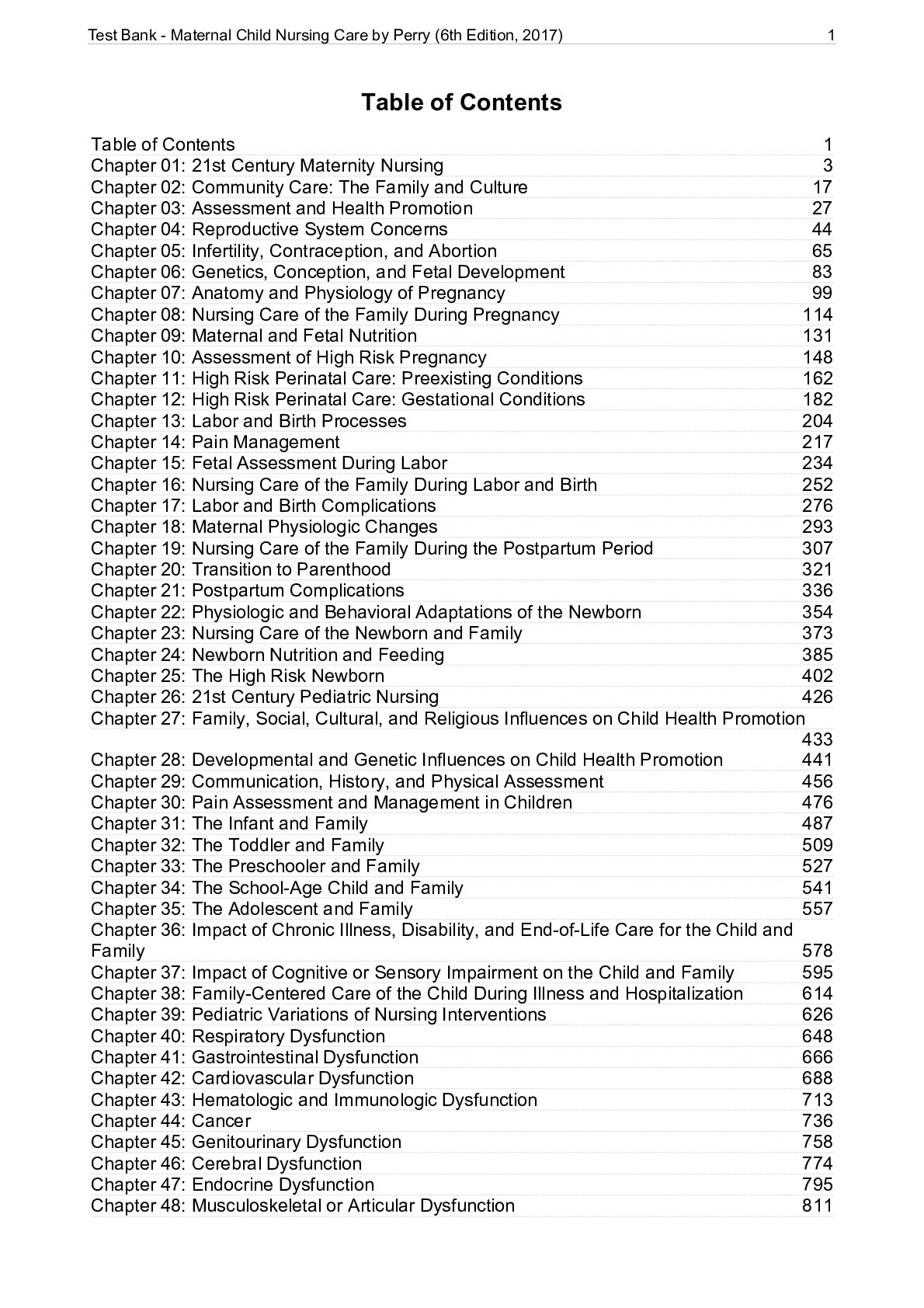

.png)
